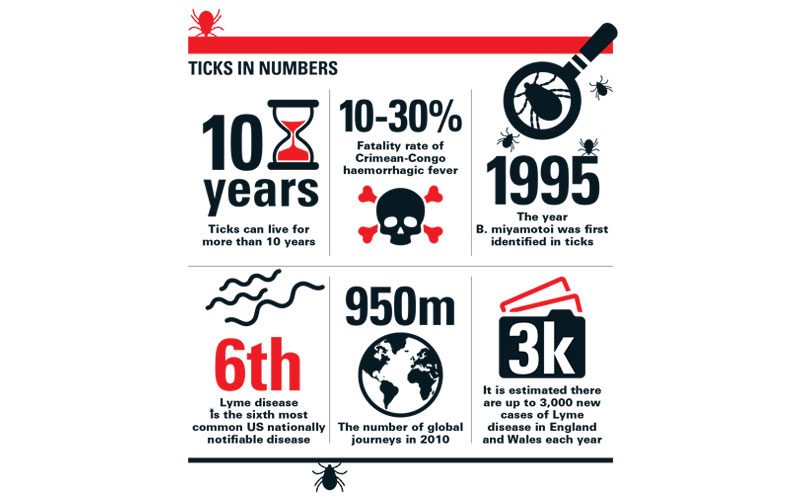With global mobility drastically increasing over recent years, Sally Cutler, Professor in Medical Microbiology, looks at the growing threat posed by tick-borne infections.

When asked what we might catch if bitten by a tick, for many of us, Lyme disease (borreliosis) might be our greatest concern. Indeed, given that this is the most commonly reported tick-borne infection within the temperate regions of the world, we would be right to consider this.
Additionally, in several countries, tick-borne encephalitis might also be considered. Again, this is a hugely important infection and a common cause of hospitalisation following tick bite in Russia and several European countries. Beyond these examples, many would start to struggle to recall other tick-borne infections, and particularly those that are newly-recognised, exotic to the UK or changing in geographical range or incidence. With exponentially increasing levels of global travel, amounting to some 950 million journeys globally in 2010, the risks of encountering infections exotic to the country of residence are significant.
It is timely to raise the profile of these infections and to consider that co-infection with multiple agents can occur, particularly among those with regular tick exposure. Detection of these cases often relies on first-line responders – hospital diagnostic laboratories.
Crimean-Congo haemorrhagic fever
Crimean-Congo haemorrhagic fever virus (CCHF), a member of the genus Nairovirus, has been rapidly spreading in Europe. It was initially detected in Crimea among military personnel in 1944, but is now known to have extensive and expanding distribution, from southern Europe and Africa through to Asia. The reasons driving this emergence are not entirely clear, but the spread of one of its major tick vectors into new habitats is undoubtedly a factor. The tick vector is typically a member of Hyalomma, such as H. marginatum, which has recently become endemic to Spain. It was just a few years from detection of this tick in Spain before the first two autochthonous cases in humans were described in 2016. Meanwhile, in Turkey cases have rapidly increased since 2002, with in excess of 10,000 human cases now reported.
As the human population is increasingly mobile, particularly during the warmer months when ticks are actively questing for blood meals, healthcare professionals should remain vigilant, even in non-endemic countries as travel-imported cases are likely to occur.
Symptoms may become noticeable between one to two weeks following tick exposure. Clinically cases present with an abrupt fever accompanied by headache, myalgia, abdominal and back pain, and vomiting. Petechial lesions involving skin and mucous membranes are common,as is bleeding that might involve various tracts, and presents a risk for nosocomial infection, particularly at venepuncture sites. Worryingly, mortality rates can reach 30%, but rarely exceed 10% in European cases.
Other tick-borne emerging viruses
The spread of CCHF is obviously concerning, but new potentially tick-borne haemorrhagic viruses are also being described. Alkhurma haemorrhagic virus has recently been described and has a fatality rate equivalent to that reported for CCHF. The reservoir for this virus has been elusive, but recent evidence has incriminated a soft tick species, Ornithodorossavingyi, as the potential vector for this virus. This tick is poorly described as a vector for pathogens in the literature, but is a particularly aggressive rapid feeding tick associated with causing toxaemia in livestock in arid areas of Africa through to Asia. Frequently feeding on camels, and other livestock species, this tick is likely to also have significant human contact. It is possible that those returning pilgrimages, such as the Hajj, might return with infection.
Atypical rickettsiosis without spots
When rickettsiosis is mentioned, you could easily be forgiven if you considered this to be exotic to the UK, and to only present as a “spotted fever”. Indeed, many cases do present this way, but it is becoming increasingly recognised that other manifestations can follow infection with R. slovacaand R. raoultii, both of which are commonly carried by Dermacentortick species. This tick is common in much of Europe and D. reticulatushas recently been reported in the UK with endemic foci in Wales, the West Country and southeast England. This tick shows a preference for biting in the hairline, so can be easily overlooked. Clinically, infections with these rickettsiae present with lymphadenitis, and not that of spotted fever. This has led to the disease being termed as Tibola/Debonel (tick-borne lymphadenopathy or Dermacentor-borne necrosis erythema and lymphadenopathy). In consequence, it is important to be aware of these alternative clinical forms of rickettsioses to guide clinicians towards successful management of cases.
Borrelia miyamotoi
Typically, relapsing fever has been linked with soft tick bites, whereas the more familiar Lyme borreliosis is transmitted by hard ticks belonging to Ixodes species. This has been challenged by the recent recognition of a relapsing fever-like spirochaete that is also transmitted by Ixodes species ticks. Human infections have been described in Russia and America among immunocompetent humans, and three neurological presentations have been described among immunocompromised humans, including one case from the Netherlands. Importantly, this infection shares the same tick vector as Lyme borreliosis and consequently has the same potential distribution. Indeed, B. miyamotoi-infected ticks have been described in the UK and much of Europe. Whether our diagnostic tests will detect such cases or these will be missed is a concern. There is heterogeneity between strains, but cases from both the US and Russia have been reported to cross-react in ELISA screening for Lyme borreliosis, however, are likely to fail to fulfil the western blot criteria for a case of Lyme. Diagnostic tests for B. miyamotoi are still under development, some utilising antigens such as glpQ, a protein possessed by relapsing fever spirochaetes, but absent from the Lyme borreliosis associated strains. Sadly, this test is not particularly sensitive, but new antigenic combinations are under evaluation.
Continuing with relapsing fever, recent cases have presented in several European countries associated with migrants from Africa. These have been cases of louse-borne relapsing fever caused by B. recurrentis, and transmitted by clothing lice. Such cases have not been encountered in Europe for many years and remind us of the need for clinical vigilance. Furthermore, novel relapsing fever species have been described, such as CandidatusBorrelia kalaharica, recently described in a German tourist returning from Africa. Whether such surprising findings will be recognised depends upon a highly-skilled diagnostic workforce, flexible diagnostic criteria coupled with informed clinical suspicion.
 Babesiosis on the increase in the US
Babesiosis on the increase in the US

During my training, Babesial infections were described in those with splenectomy, but as relatively insignificant pathogens in those with intact spleens. This is now significantly challenged, particularly with emerging data from US. In America an unprecedented increase in human babesiosis has been observed, intriguingly in areas where Lyme disease is endemic. This has led to the hypothesis that these pathogens might interact in a synergistic way, with one agent facilitating the presence of the other. Whether this effect occurs at the level of tick interactions, or if the pathogen combination results in enhanced immunosuppression within the infected human, has yet to be fully resolved. Epidemiological evidence has shown significant increases in cases of human babesiosis in those regions already endemic for Lyme disease. There are therapeutic implications as the normal regime of doxycycline used to manage Lyme disease will be ineffective with regard to Babesia. The European picture is less clear. Prevalent species of Borrelia, Babesia and ticks differ and thus it is impossible to extrapolate these findings. This said, increases in reported cases have been observed, but this could have resulted from improvements in diagnostic awareness.
Concluding remarks
In conclusion, our understanding of tick-borne infections is far from complete. New pathogens are being detected, recognised pathogens are emerging into new areas and our understanding of potential synergies (or inhibitory interactions) of different pathogens enhancing survival in ticks, vertebrate hosts, or impacting upon clinical severity in humans remains to be fully explored.
Sally Jane Cutler is Professor in Medical Microbiology at University of East London.




